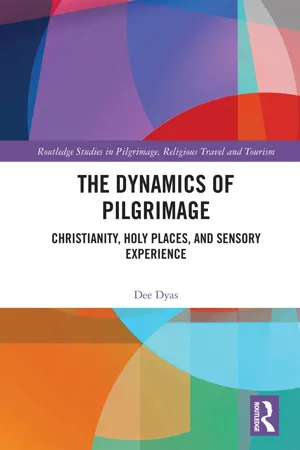
The Dynamics of Pilgrimage
Christianity, Holy Places, and Sensory Experience
Dee Dyas
- 360 pagine
- English
- ePUB (disponibile sull'app)
- Disponibile su iOS e Android
The Dynamics of Pilgrimage
Christianity, Holy Places, and Sensory Experience
Dee Dyas
Informazioni sul libro
This book offers a systematic, chronological analysis of the role played by the human senses in experiencing pilgrimage and sacred places, past and present. It thus addresses two major gaps in the existing literature, by providing a broad historical narrative against which patterns of continuity and change can be more meaningfully discussed, and focusing on the central, but curiously neglected, area of the core dynamics of pilgrim experience.
Bringing together the still-developing fields of Pilgrimage Studies and Sensory Studies in a historically framed conversation, this interdisciplinary study traces the dynamics of pilgrimage and engagement with holy places from the beginnings of the Judaeo-Christian tradition to the resurgence of interest evident in twenty-first century England. Perspectives from a wide range of disciplines, from history to neuroscience, are used to examine themes including sacred sites in the Bible and Early Church; pilgrimage and holy places in early and later medieval England; the impact of the English Reformation; revival of pilgrimage and sacred places during the nineteenth and twentieth Centuries; and the emergence of modern place-centred, popular 'spirituality'.
Addressing the resurgence of pilgrimage and its persistent link to the attachment of meaning to place, this book will be a key reference for scholars of Pilgrimage Studies, History of Religion, Religious Studies, Sensory Studies, Medieval Studies, and Early Modern Studies.
Domande frequenti
Informazioni
Part I The background
1 The senses, the world, and the pilgrim
Introduction: exploring the dynamics of pilgrimage
Indice dei contenuti
- Cover
- Half Title
- Series Page
- Title Page
- Copyright Page
- Dedication
- Contents
- Acknowledgements
- Introduction
- PART I The background
- PART II Sensory experience and the power of place in England c.597-c.1540
- PART III Sensory experience and the power of place in England: the reformation to the present day
- Postscript
- Bibliography
- Index